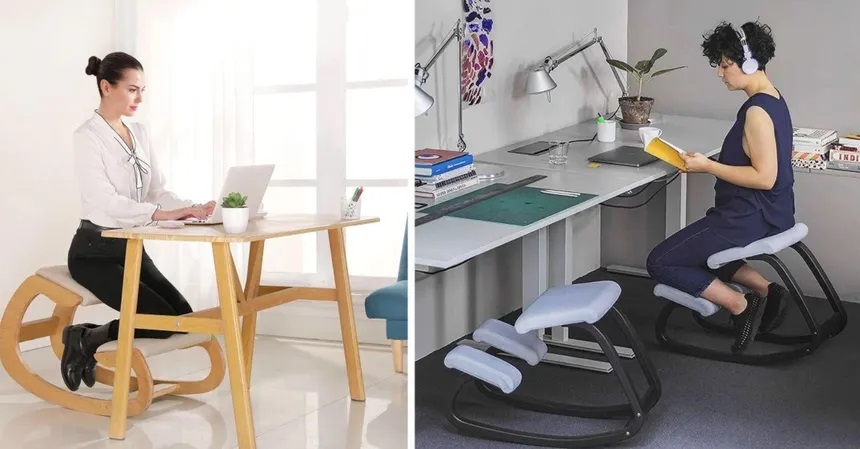In today’s fast-paced work culture, where long hours at a desk have become the norm, many professionals are turning to alternative seating solutions like the ergonomic kneeling desk chair/. Designed to reduce pressure on the lower back and encourage a more natural posture, this chair is gaining popularity among individuals who prioritize wellness and productivity. From freelance workers to corporate employees, the ergonomic kneeling desk chair is challenging conventional seating standards.
This chair looks nothing like a traditional office seat. It typically features a sloped seat and padded knee rests, which encourage the user to distribute weight between the knees and buttocks. The goal is to maintain the natural curve of the spine and reduce the compression that comes from sitting for hours in a standard chair. While at first glance it may appear unconventional, the logic behind its design is rooted in science and ergonomics.
The Origins of the Kneeling Desk Chair
The concept of a kneeling chair isn’t brand-new. In fact, the earliest versions emerged in the 1970s, designed with the intention of alleviating lower back pain by promoting a more upright sitting posture. Over time, the chair’s design has evolved to incorporate adjustable height options, stronger frames, and more comfortable padding. The modern ergonomic kneeling desk chair represents the fusion of timeless ergonomic principles with contemporary innovation.
Interestingly, just as the smart watch women market has shifted towards wellness and multifunctional tech, kneeling chairs have also transformed from niche gadgets into mainstream wellness tools. Both products aim to empower users with better health choices in everyday routines.
Understanding How It Works
When you sit in an ergonomic kneeling desk chair, your thighs slope downward at an angle of about 60 to 70 degrees instead of the usual 90 degrees. This position tilts the pelvis forward and aligns the spine into a more natural S-shape. Unlike traditional chairs that encourage slouching or leaning back, this posture supports the core muscles and promotes spinal alignment.
This seating position helps engage the muscles of the lower back and abdomen, resulting in improved balance and posture. Because part of your body’s weight is supported by your shins and knees, it reduces strain on the lumbar spine. However, it’s worth noting that the ergonomic kneeling desk chair is not necessarily designed for full-day use. Experts often recommend switching between this and other seating options to avoid discomfort.
Key Benefits of Using an Ergonomic Kneeling Desk Chair
One of the primary advantages of the kneeling chair is that it actively promotes better posture. Most users notice a significant difference in spinal alignment and core strength over consistent usage. In addition to posture, these chairs are known to:
- Reduce lower back pain
- Enhance concentration and energy levels
- Prevent slouching and related muscular strain
- Improve circulation in the lower body
People with sedentary desk jobs have found this to be a healthier way to sit, particularly when performing tasks that require focus and attention to detail. Just like a smart watch women design encourages more daily activity, this chair nudges users toward better postural habits.
Things to Consider Before Switching
Before you toss out your traditional desk chair, there are a few things to consider. An ergonomic kneeling desk chair may not be for everyone. The transition period can be challenging as your body adapts to a new way of sitting. Some people experience initial discomfort, especially in the shins or knees.
Experts advise starting with short sessions of 15 to 30 minutes and gradually increasing the time. It’s also helpful to pair the chair with a desk of adjustable height to ensure a comfortable setup. Lastly, consider your personal health conditions. If you have knee problems, circulation issues, or difficulty getting in and out of low-seated furniture, it’s best to consult a medical professional first.
Differences Between Kneeling Chairs and Regular Office Chairs
Unlike regular office chairs, which are padded and allow you to recline or swivel, ergonomic kneeling chairs are more focused on stability and alignment. They don’t have backrests in most cases and rarely include armrests. The main goal is to correct posture and reduce spinal stress. A traditional office chair can often contribute to poor posture over time, especially if it lacks lumbar support.
Another difference is movement. Since kneeling chairs often come without wheels or a rotating base, you remain more stationary. This encourages you to maintain your core position and avoid unnecessary slouching. However, this may not suit users who require flexibility and movement while working.
How It Supports Long-Term Wellness
Investing in an ergonomic kneeling desk chair is more than just a comfort upgrade—it’s a commitment to long-term spinal and muscular health. Sitting in a chair that supports your natural posture can lead to a noticeable decrease in chronic pain. Some users have reported fewer headaches, reduced neck tension, and even improved digestion due to less compression on abdominal organs.
In this way, it shares the same wellness goals as wearable tech, like smart watch women editions, which promote health tracking and movement. When used mindfully, the kneeling chair becomes a tool in your broader lifestyle strategy to improve well-being.
Who Should Use an Ergonomic Kneeling Desk Chair?
These chairs are ideal for people who work at desks for extended periods and are actively seeking alternatives to conventional office setups. Writers, designers, programmers, and remote workers often make great candidates. It’s also useful for students who spend a lot of time studying.
However, the chair isn’t universally suitable. Individuals with joint problems or specific medical conditions should approach this furniture with caution. If you have difficulty kneeling or experience knee pain easily, it may not be the best option. Testing one before purchase or opting for a model with extra cushioning could help ease the transition.
How to Transition Effectively
Switching to a kneeling chair requires some adjustment. Most people find that their lower back and core muscles get sore after the first few days because they’re being used more actively. Here are some suggestions for making the switch easier:
Start by alternating between your traditional chair and the ergonomic kneeling desk chair. Use it for short sessions, gradually increasing the time as your body adjusts. Stretch regularly, especially your hip flexors and hamstrings, since they remain engaged while seated. And always pay attention to your comfort—listen to your body’s signals.
Pairing with a Proper Workspace Setup
For best results, pair your kneeling chair with an adjustable-height desk. This ensures that your arms remain at a comfortable angle while typing. Monitor height also matters; the top of your screen should be at eye level to avoid neck strain.
It might also help to use a footrest or anti-fatigue mat beneath the chair to provide extra comfort for your knees. These small details can make a big difference in overall comfort and efficiency.
Ergonomics in Everyday Life
Incorporating ergonomics into everyday life goes beyond the type of chair you use. It’s about being mindful of how your body interacts with the tools and environments around you. Choosing an ergonomic kneeling desk chair is just one of many decisions you can make to support better health.
Just as many people are now tracking their steps, hydration, and heart rate using gadgets like a smart watch women rely on for fitness motivation, choosing the right seating can be a conscious part of a health-first lifestyle. Ergonomics is not a trend—it’s a long-term approach to better living.
What Users Are Saying
Many users report feeling more alert and engaged after switching to a kneeling chair. Others say they’ve experienced fewer headaches and muscle spasms. While individual experiences vary, the general consensus is that this chair offers noticeable improvements in focus, alignment, and posture.
Still, some users emphasize the importance of balance. It shouldn’t be the only chair you use throughout the day. Rotating between various seating options, including standing desks and stability balls, may offer the best results overall.
Final Thoughts
So, what is an ergonomic kneeling desk chair, and how does it work? It’s a thoughtfully designed seating solution that encourages proper posture, reduces spinal pressure, and strengthens core muscles. By changing how you sit, it changes how you feel—and potentially, how you work.
It’s not just a quirky office upgrade; it’s part of a broader movement toward conscious wellness. In the same way that wearable fitness devices like smart watch women models have reshaped how we approach health tracking, kneeling chairs offer a new perspective on desk-bound lifestyles. They challenge us to sit smarter, move often, and take control of our comfort.

